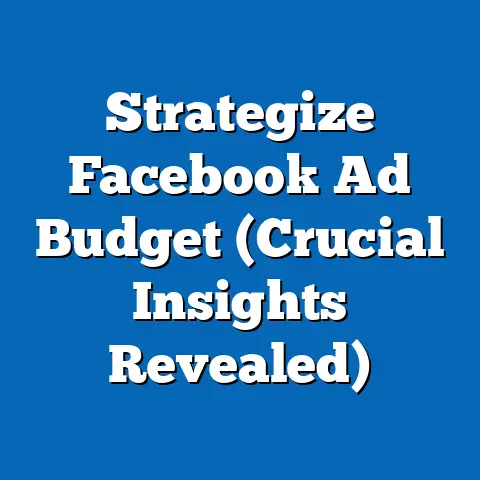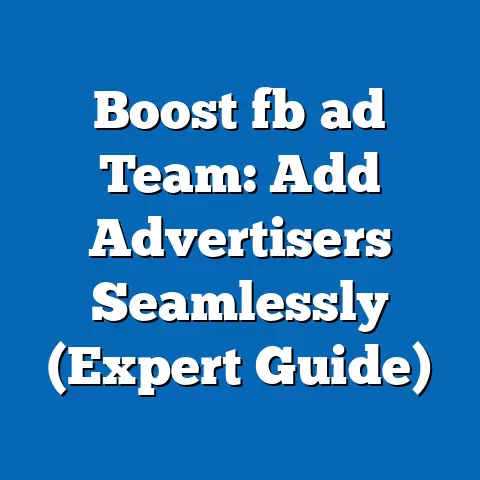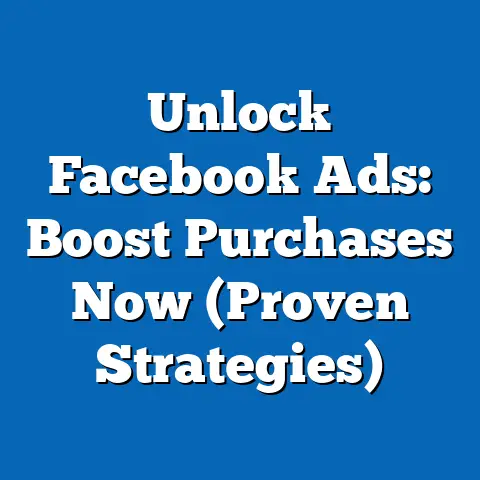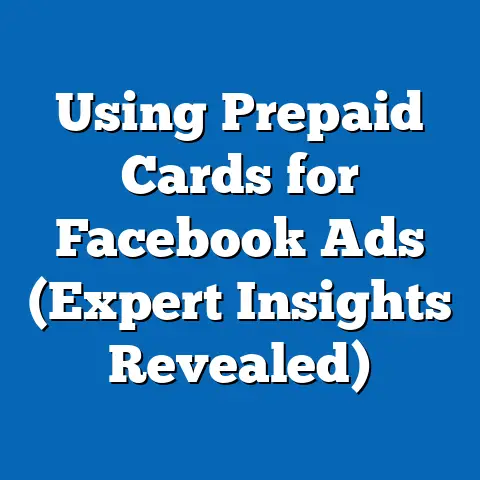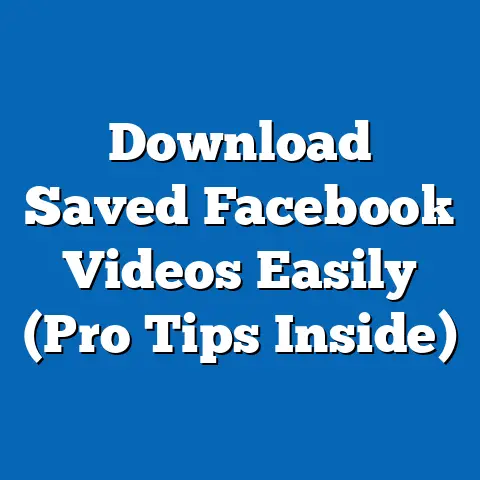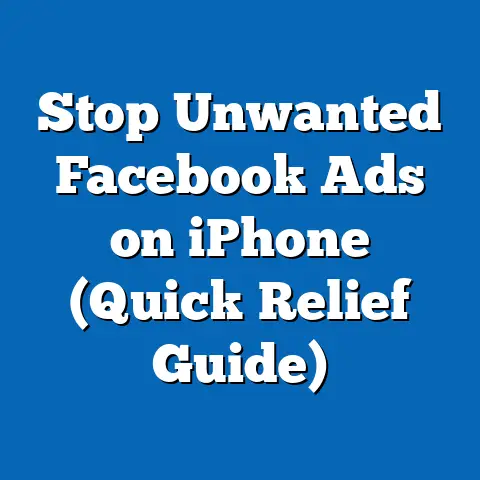Unlock DIY Ads Success on Facebook (Expert Tips Revealed)
What if you could create your own Facebook ad campaign that not only captures attention but also drives conversions like never before? Imagine waking up to notifications of sales and leads pouring in, all thanks to a Facebook ad you designed yourself. What if the power to transform your business was at your fingertips, requiring just a bit of creativity and strategy?
I remember the early days of my marketing career, feeling completely overwhelmed by the idea of Facebook ads. It seemed like a complex maze of algorithms, targeting options, and bidding strategies. But I quickly realized that with a bit of knowledge and a willingness to experiment, anyone can create effective Facebook ads. The key is to understand the fundamentals, set clear goals, and consistently analyze your results.
Facebook advertising isn’t just for big corporations with massive marketing budgets. In fact, it’s an incredibly powerful tool for small businesses and entrepreneurs who are looking to reach a specific audience and drive measurable results. With the right approach, you can create DIY Facebook ads that resonate with your audience, generate leads, and boost sales.
In this article, I’m going to share my expert tips for creating DIY Facebook ads that not only capture attention but also drive conversions. I’ll guide you through the process step by step, from understanding the basics of Facebook ads to analyzing your results and scaling your successful campaigns. Let’s dive in!
Understanding Facebook Ads
Facebook ads are paid messages that businesses can use to reach a specific audience on the Facebook platform. Unlike organic posts, which are only seen by your followers and their friends, Facebook ads can be targeted to anyone who meets your criteria, regardless of whether they follow your page or not.
Facebook ads function through a bidding system. You set a budget and bid for ad placements, and Facebook uses an algorithm to determine which ads to show to which users based on factors like your bid, ad quality, and relevance.
There’s a whole spectrum of ad types available. Here are a few of the most common types of Facebook ads:
- Image Ads: These are the simplest type of ad, featuring a single image and text. They’re great for showcasing products or services in a visually appealing way.
- Video Ads: Video ads are more engaging than image ads and can be used to tell a story or demonstrate a product in action.
- Carousel Ads: Carousel ads allow you to showcase multiple images or videos in a single ad, each with its own headline, description, and link. They’re perfect for showcasing a range of products or highlighting different features of a single product.
- Slideshow Ads: Slideshow ads are similar to video ads, but they use a series of images to create a short video-like experience. They’re a great option for businesses that don’t have the resources to create high-quality video content.
- Collection Ads: Collection ads are designed to showcase products in a catalog format. They’re perfect for e-commerce businesses that want to drive sales directly from Facebook.
One of the most powerful aspects of Facebook ads is the ability to target your audience based on a wide range of factors, including demographics (age, gender, location), interests, behaviors, and connections. Facebook’s audience segmentation tools allow you to narrow down your target audience to the people who are most likely to be interested in your products or services.
Here’s why Facebook ads are so effective:
- Reach: Facebook has billions of active users, giving you the potential to reach a massive audience.
- Targeting: Facebook’s sophisticated targeting options allow you to reach the right people with the right message.
- Measurability: Facebook provides detailed analytics that allow you to track the performance of your ads and make data-driven decisions.
- Flexibility: Facebook offers a wide range of ad formats and bidding options, allowing you to create campaigns that meet your specific needs and budget.
Real-world example: I once worked with a small bakery that was struggling to attract new customers. We created a Facebook ad campaign targeting people in the local area who were interested in baking, desserts, and local businesses. The ads featured mouth-watering photos of the bakery’s products and offered a special discount for first-time customers. Within a few weeks, the bakery saw a significant increase in foot traffic and sales.
Key Takeaway: Facebook ads are a powerful tool for reaching a specific audience and driving measurable results. Understanding the different ad types, targeting options, and bidding strategies is essential for creating effective campaigns.
Setting Goals for Your Campaign
Before you start creating your Facebook ads, it’s crucial to set clear, measurable goals. What do you want to achieve with your campaign? Are you looking to increase brand awareness, generate leads, drive website traffic, or boost sales?
Setting goals is important because it provides a roadmap for your campaign and allows you to track your progress. Without clear goals, it’s difficult to determine whether your ads are actually working and whether you’re getting a return on your investment.
Here are some different types of goals you might consider for your Facebook ad campaign:
- Brand Awareness: If your goal is to increase brand awareness, you’ll want to focus on reaching as many people as possible with your ads. You’ll want to track metrics like impressions (the number of times your ad is shown) and reach (the number of unique people who see your ad).
- Lead Generation: If your goal is to generate leads, you’ll want to focus on capturing contact information from potential customers. You can use lead ads, which allow people to sign up for your email list directly from Facebook, or you can drive traffic to a landing page on your website where people can fill out a form.
- Website Traffic: If your goal is to drive traffic to your website, you’ll want to focus on creating ads that are relevant to your target audience and that entice them to click through to your site. You’ll want to track metrics like click-through rate (CTR) and website visitors.
- Conversions: If your goal is to drive conversions (e.g., sales, sign-ups, downloads), you’ll want to focus on creating ads that are highly targeted and that offer a clear call to action. You’ll want to track metrics like conversion rate and cost per acquisition (CPA).
To ensure your goals are effective, use the SMART criteria:
- Specific: Your goal should be clearly defined and easy to understand.
- Measurable: You should be able to track your progress towards your goal using specific metrics.
- Achievable: Your goal should be realistic and attainable.
- Relevant: Your goal should align with your overall business objectives.
- Time-bound: You should set a deadline for achieving your goal.
Examples of SMART goals for Facebook ad campaigns:
- Brand Awareness: Increase brand awareness by 20% among women aged 25-34 in the local area within the next month.
- Lead Generation: Generate 100 qualified leads for our new product within the next two weeks.
- Website Traffic: Drive 500 new visitors to our website from Facebook ads within the next week.
- Conversions: Increase sales of our online course by 15% within the next month.
Real-world example: I worked with a local gym that wanted to generate more leads for their personal training program. We set a goal of generating 50 qualified leads within the next month. To achieve this goal, we created a Facebook ad campaign targeting people in the local area who were interested in fitness, weight loss, and healthy living. The ads featured testimonials from satisfied clients and offered a free consultation with a personal trainer. Within a month, the gym had generated over 60 qualified leads, exceeding their initial goal.
Key Takeaway: Setting clear, measurable goals is essential for creating effective Facebook ad campaigns. Use the SMART criteria to ensure your goals are specific, measurable, achievable, relevant, and time-bound.
Crafting Compelling Ad Content
Once you’ve set your goals, it’s time to start crafting compelling ad content. This includes creating eye-catching visuals and writing persuasive copy that grabs attention and entices people to take action.
Visuals:
Your visuals are the first thing people will see, so it’s important to make them stand out. Use high-quality images or videos that are relevant to your target audience and that align with your brand identity.
Here are some tips for creating eye-catching visuals:
- Use bright colors: Bright colors are more likely to grab attention than dull colors.
- Use faces: People are naturally drawn to faces, so including faces in your visuals can help to increase engagement.
- Showcase your product or service: Make sure your visuals clearly showcase your product or service.
- Use a consistent style: Your visuals should have a consistent style that aligns with your brand identity.
Copywriting:
Your ad copy is just as important as your visuals. Your headline and description should be clear, concise, and persuasive. They should also highlight the benefits of your product or service and include a strong call to action.
Here are some tips for writing effective ad copy:
- Write a compelling headline: Your headline should grab attention and make people want to learn more.
- Highlight the benefits: Focus on the benefits of your product or service, rather than just the features.
- Use strong verbs: Use strong verbs to create a sense of urgency and excitement.
- Include a call to action: Tell people exactly what you want them to do (e.g., “Shop Now,” “Learn More,” “Sign Up”).
Storytelling:
One of the most effective ways to connect with your audience is to use storytelling techniques in your ads. Tell a story that resonates with your target audience and that highlights the benefits of your product or service.
Call to Action (CTA):
Your call to action is one of the most important parts of your ad. It tells people exactly what you want them to do. Make sure your CTA is clear, concise, and persuasive.
Here are some examples of effective CTAs:
- Shop Now
- Learn More
- Sign Up
- Get Started
- Download Now
- Contact Us
Real-world example: I worked with a local restaurant that wanted to promote their new menu. We created a Facebook ad campaign featuring mouth-watering photos of their dishes and copy that highlighted the fresh, local ingredients they used. The ads also included a strong call to action: “Book Your Table Now.” As a result, the restaurant saw a significant increase in reservations.
Key Takeaway: Crafting compelling ad content is essential for capturing attention and driving conversions. Use high-quality visuals, write persuasive copy, and include a strong call to action.
Targeting Your Audience
One of the most powerful aspects of Facebook ads is the ability to target your audience based on a wide range of factors. This allows you to reach the people who are most likely to be interested in your products or services.
Facebook offers a variety of audience targeting options, including:
- Demographics: You can target people based on their age, gender, location, education, and other demographic factors.
- Interests: You can target people based on their interests, such as hobbies, sports, and entertainment.
- Behaviors: You can target people based on their behaviors, such as their purchase history, online activity, and device usage.
- Custom Audiences: You can create custom audiences based on your existing customer data, such as email lists, website visitors, and app users.
Creating a buyer persona is crucial for effective targeting. A buyer persona is a fictional representation of your ideal customer. It’s based on research and data about your existing customers and potential customers.
To create a buyer persona, consider the following factors:
- Demographics: What is your ideal customer’s age, gender, location, education, and income level?
- Interests: What are your ideal customer’s hobbies, interests, and passions?
- Behaviors: What are your ideal customer’s online habits, purchase history, and device usage?
- Pain Points: What are your ideal customer’s challenges and frustrations?
- Goals: What are your ideal customer’s goals and aspirations?
Facebook’s Audience Insights tool is a valuable resource for informing your targeting decisions. It allows you to learn more about your target audience, including their demographics, interests, and behaviors.
Retargeting audiences who have interacted with your brand previously is a highly effective strategy. You can retarget people who have visited your website, watched your videos, or engaged with your Facebook page.
Real-world example: I worked with an online clothing store that wanted to increase sales. We created a Facebook ad campaign targeting women aged 25-34 who were interested in fashion, online shopping, and specific clothing brands. We also created a custom audience based on people who had visited the store’s website but hadn’t made a purchase. The ads featured photos of the store’s clothing and offered a discount for first-time customers. As a result, the store saw a significant increase in sales.
Key Takeaway: Targeting your audience effectively is essential for maximizing the impact of your Facebook ads. Use Facebook’s targeting options, create a buyer persona, and leverage the Audience Insights tool.
Budgeting and Bidding Strategies
Setting a budget for your Facebook ads is crucial for managing your ad spend and ensuring you’re getting a return on your investment. The right budget will depend on your business goals, target audience, and the competition in your industry.
Facebook offers two main bidding strategies:
- Automatic Bidding: With automatic bidding, Facebook automatically sets your bids to get the most results for your budget. This is a good option for beginners or for campaigns where you’re not sure what your bids should be.
- Manual Bidding: With manual bidding, you set your bids manually. This gives you more control over your ad spend, but it also requires more knowledge and experience.
Maximizing ad spend efficiency and minimizing cost per acquisition (CPA) is essential for getting the most out of your Facebook ads.
Here are some tips for maximizing ad spend efficiency:
- Target the right audience: Make sure you’re targeting the right audience with your ads.
- Create compelling ad content: Your ads should be eye-catching and persuasive.
- Test different ad formats: Experiment with different ad formats to see which ones perform best.
- Monitor your ad performance: Keep a close eye on your ad performance and make adjustments as needed.
Real-world example: I worked with a local coffee shop that wanted to promote their new loyalty program. We set a daily budget of $20 and used automatic bidding. The ads targeted people in the local area who were interested in coffee and local businesses. The ads featured photos of the coffee shop and offered a free drink for signing up for the loyalty program. Within a few weeks, the coffee shop had gained hundreds of new loyalty program members.
Key Takeaway: Setting a budget and choosing the right bidding strategy are essential for managing your ad spend and maximizing your ROI. Monitor your ad performance and make adjustments as needed.
Analyzing and Optimizing Ad Performance
Tracking key performance indicators (KPIs) is essential for understanding how your ads are performing and for making data-driven decisions. Some of the most important KPIs to track include:
- Click-Through Rate (CTR): The percentage of people who click on your ad after seeing it.
- Conversion Rate: The percentage of people who take a desired action (e.g., making a purchase, signing up for a newsletter) after clicking on your ad.
- Engagement Rate: The percentage of people who interact with your ad (e.g., liking, commenting, sharing).
Facebook Ads Manager is a powerful tool for analyzing ad performance and gaining insights into audience behavior. It allows you to track your KPIs, see how your ads are performing, and make adjustments to your campaigns.
Here are some actionable steps for optimizing your ads based on performance data:
- A/B Testing: Test different versions of your ads to see which ones perform best.
- Adjusting Targeting: Refine your targeting to reach the people who are most likely to be interested in your products or services.
- Optimizing Ad Content: Improve your ad copy and visuals to make your ads more engaging and persuasive.
Real-world example: I worked with an e-commerce store that was running a Facebook ad campaign to promote their new line of products. We noticed that the click-through rate was low, so we decided to A/B test different headlines. After testing several different headlines, we found one that significantly increased the click-through rate. As a result, the store saw a significant increase in sales.
Key Takeaway: Analyzing and optimizing your ad performance is essential for maximizing your ROI. Track your KPIs, use Facebook Ads Manager to gain insights into audience behavior, and make adjustments to your campaigns based on performance data.
Scaling Your Facebook Ads
Once you’ve created a successful ad campaign, you may want to scale it to reach a larger audience and generate even more results.
Scaling a successful ad campaign involves increasing your budget and reach. However, it’s important to do this carefully to avoid diluting your results.
Maintaining ad relevance and quality is crucial as you increase your budget and reach. Make sure your ads are still relevant to your target audience and that they provide value.
Here are some strategies for expanding audience targeting and diversifying ad content while scaling:
- Lookalike Audiences: Create lookalike audiences based on your existing customer data.
- Interest-Based Targeting: Expand your interest-based targeting to reach new audiences.
- Ad Format Diversification: Try different ad formats to see which ones perform best with your new audiences.
Real-world example: I worked with a software company that had created a successful Facebook ad campaign to generate leads for their product. We decided to scale the campaign by increasing the budget and creating lookalike audiences based on their existing customer data. As a result, the company saw a significant increase in leads and sales.
Key Takeaway: Scaling your Facebook ads can be a great way to reach a larger audience and generate even more results. However, it’s important to do this carefully to avoid diluting your results.
Conclusion
DIY Facebook ads can be a powerful tool for driving business success. By understanding the fundamentals, setting clear goals, crafting compelling ad content, targeting your audience effectively, managing your budget and bidding strategies, analyzing and optimizing your ad performance, and scaling your successful campaigns, you can create Facebook ads that resonate with your audience, generate leads, and boost sales.
I encourage you to take action and start your own Facebook ad campaign with the tips I’ve provided. The world of social media advertising is constantly evolving, so it’s important to continually learn and adapt.
Remember my initial experience with Facebook ads? The one where I felt overwhelmed? Well, I turned that around through continuous learning and experimentation. And I know you can too!
Now, I’d love to hear from you! Share your DIY ad success stories or questions in the comments section below. Let’s create a community of learning and support and help each other achieve our advertising goals.
Call-to-Action:
Share your DIY ad success stories or questions in the comments section below! Let’s build a community and learn from each other.

